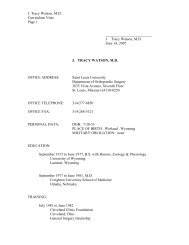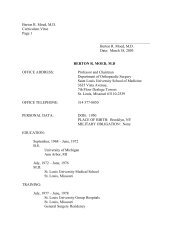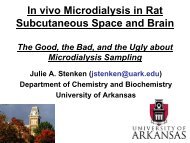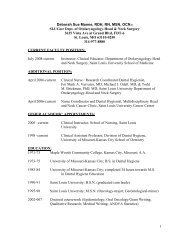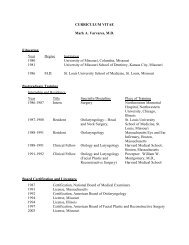Living Image 3.1
Living Image 3.1
Living Image 3.1
Create successful ePaper yourself
Turn your PDF publications into a flip-book with our unique Google optimized e-Paper software.
<strong>Living</strong> <strong>Image</strong> ® Software User’s Manual<br />
G.2 Optical Properties<br />
G.3 Luciferase Spectrum<br />
The results of the fit are the total flux of the bioluminescence source S and the source depth<br />
d.<br />
Planar spectral image analysis requires prior knowledge of the tissue optical properties at<br />
the wavelength used at image acquisition. The two main optical parameters are the:<br />
• Absorption coefficient (µ a ) that defines the inverse of the mean path before photons<br />
are absorbed by the tissue.<br />
• Reduced scattering coefficient (µ' s ) that defines the inverse of the mean path before<br />
photons are scattered isotropically in the tissue.<br />
The effective attenuation coefficient (µ eff ) is a function of the absorption and reduced<br />
scattering coefficients:<br />
µ eff = (3µ a (µ' s + µ a )) 1/2 (2)<br />
Calculation of the function K in Equation 1 requires all three coefficients (µ a , µ' s , and µ eff )<br />
as input. The function K includes a term called the effective reflection coefficient to account<br />
for the reflection of light at the air-tissue boundary due to a mismatch in the index of<br />
refraction. The tissue index of refraction is generally assumed to be close to 1.4.<br />
The model assumes that the tissues are optically homogeneous and the <strong>Living</strong> <strong>Image</strong><br />
software provides several factory set tissue optical property values to choose from.<br />
Analyzing spectrally filtered images requires knowledge of the spectral dependence of<br />
bioluminescent light emission. The luciferase bioluminescence spectrum was measured in<br />
vitro at 37° C and pH≈ 7 in various cell lines. This spectrum is used to normalize the photon<br />
flux values that the software measures at each wavelength.<br />
Source spectra for several reporters are included in the database, including firefly, click<br />
beetle, renilla, and bacteria (Figure G.1).<br />
NOTE<br />
G.4 An Example of Planar Spectral Imaging<br />
The firefly luciferase spectrum is temperature and pH dependent. The luciferase<br />
spectra included in the software are only valid for measurements performed at 37° C<br />
and pH 7.0-7.5. If you use other temperature or pH conditions for an experiment, the<br />
associated luciferase spectral curve is required for planar spectral image analysis. For<br />
more information on the pH and temperature dependence of the luciferase spectrum,<br />
please contact Xenogen Corporation.<br />
Melanoma cells were injected intravenously into the tail vein of nude mice. After 13 days,<br />
metastases developed in the lungs, kidney, and hind limb bone. An image sequence was<br />
acquired on the IVIS ® Imaging System 200 Series using filters at six wavelengths from 560<br />
to 660 nm, in 20 nm intervals.<br />
227




